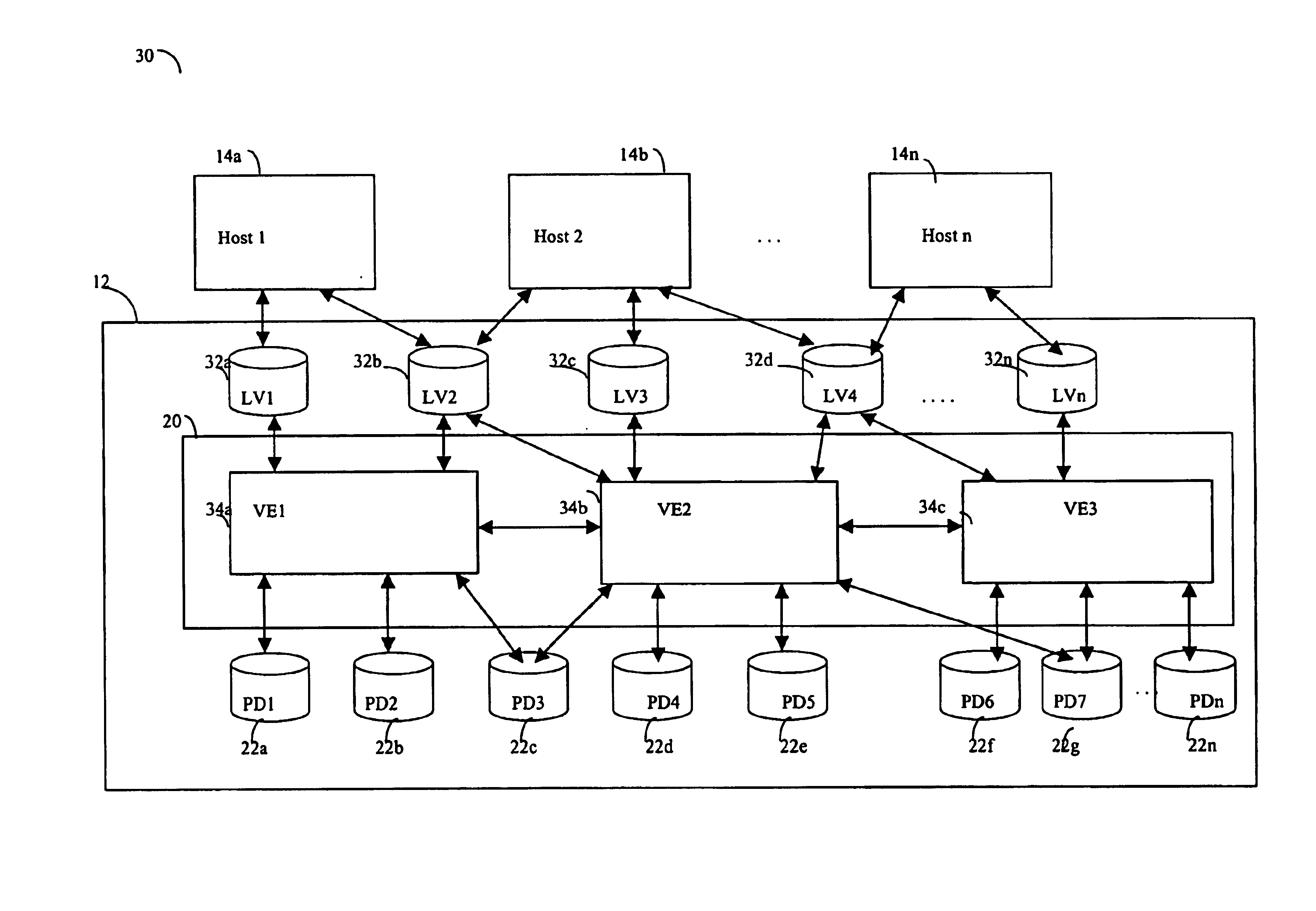Locking technique for control and synchronization
a technology of data storage and locking, applied in the field of computer data storage, can solve the problem of increasing the amount of time it takes to dispatch data operations to the data storage device, and achieve the effect of reducing the amount of time it takes to dispatch data operations
- Summary
- Abstract
- Description
- Claims
- Application Information
AI Technical Summary
Benefits of technology
Problems solved by technology
Method used
Image
Examples
embodiment 42
[0078]Referring now to FIG. 4B, shown is an example of another embodiment of how a plurality of hosts may communicate with physical devices. The embodiment 42 includes a 16 port switch with 12 ports, 45a-45l, connected in pairs to 6 hosts, H1-H6, with the remaining 4 ports, 45 m-45p, connected in pairs to two data storage devices Dev1 and Dev2. In this instance, the FPs may be logically and possibly physically, located on each of the host ports and each host is communicating to two FPs.
[0079]Referring now to FIG. 4C, shown is another embodiment of how a plurality of hosts may communicate with physical devices. FIG. 4C shows a configuration 46 which is a modification of the configuration 42 from FIG. 4B but with one of the hosts (H4) removed and two switches(47a and 47b) in place of the host, each of the two switches having 16 ports. Each of the two switches 47a and 47b plugs into locations 45g and 45h includes in the original switch 43. On the two newly added switches 47a and 47b, 1...
embodiment 280
[0117]Referring now to FIG. 11, shown is an example of an embodiment 280 of how the LBA Rmap and storage redirect table may be used in connection with a multipathing technique. An incoming virtual address V1 is determined to be in the volume descriptor that includes LBA Rmap 282. In particular, it refers to the second entry in the LBA Rmap table 282. The second entry of the LBA Rmap table includes a 1 as indicated by element 281. When an incoming I / O operation uses the path specified by storage redirect table entry 1, an I / O failure may occur and the CP may get involved to perform a path test to device 290 along the path specified by the storage redirect table entry 1. The CP may determine that storage redirect table entries 1 and 2 specify two different paths to the same device 290. Upon an I / O failure, the CP may determine that the particular path specified by storage redirect table entry 1 has indeed failed. The CP may then reconfigure the destination of the volume segment descri...
embodiment 460
[0146]Referring now to FIG. 17, shown is a flowchart of steps of an embodiment 460 that may be performed by the CP in connection with the serialization operations. The CP may serialize I / Os, for example, either because the FP is incapable of doing the serialization or because the FP faulted in I / O to the CP such as when a serialization violation is detected. At step 462, the CP receives an I / O request such as a write I / O request. At step 464, a determination is made as to whether there are I / O requests in the physical or downstream pending I / O list overlapping the LBA range of the received I / O request. If not, control proceeds to step 470 where the I / O request is queued to the FP such that the FP will again later retry the operation.
[0147]If at step 464 it is determined there is an overlap between the LBA range of the I / O request and the LBA range of other pending I / O requests in the physically pending I / O list, control proceeds to step 466 where the FP is blocked or prevented from ...
PUM
 Login to View More
Login to View More Abstract
Description
Claims
Application Information
 Login to View More
Login to View More - R&D
- Intellectual Property
- Life Sciences
- Materials
- Tech Scout
- Unparalleled Data Quality
- Higher Quality Content
- 60% Fewer Hallucinations
Browse by: Latest US Patents, China's latest patents, Technical Efficacy Thesaurus, Application Domain, Technology Topic, Popular Technical Reports.
© 2025 PatSnap. All rights reserved.Legal|Privacy policy|Modern Slavery Act Transparency Statement|Sitemap|About US| Contact US: help@patsnap.com



